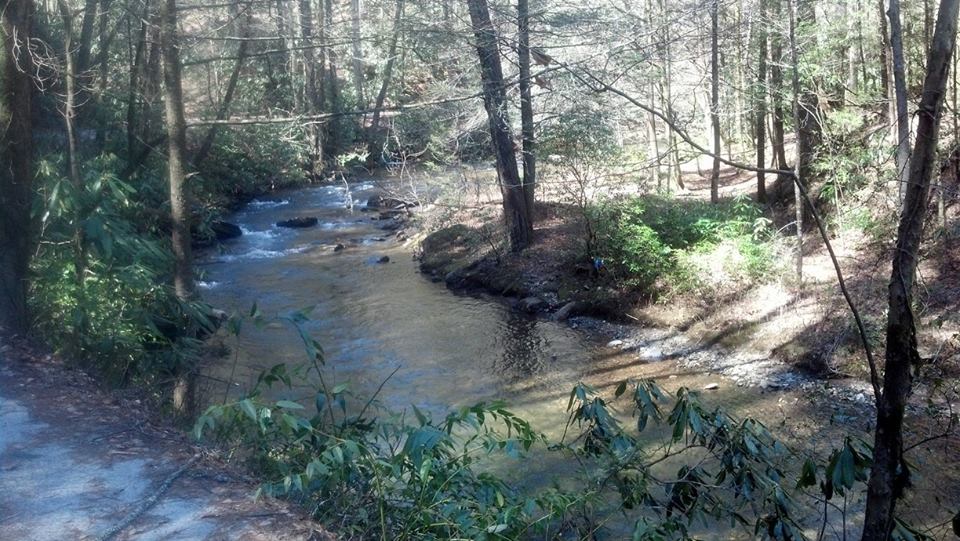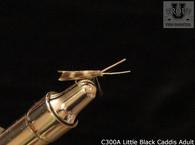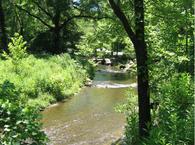
The Chattahoochee River begins as a collection of tiny streams about 20 or 30 miles north of Helen, Georgia in the Blue Ridge Mountains. It is a freestone stream so typical of the southern white water streams. The most uppermost part of the stream, as well as its tributaries, contains a healthy population of brook trout. They have no competition from the rainbow trout since the rainbows can not get beyond the natural waterfall above the confluence of Henson Creek.
In the lower section of the Upper Chattahoochee River near Helen, there is very little natural reproduction and therefore, the trout are predominately hatchery bred with very few holdovers. The good news is that the lower section is more accessible. The Chattahoochee Wildlife Management Area is populated with both wild bred trout and hatchery supported trout. The river consists of pocket water with some pools between short riffles and runs. Often times the trout are more abundant in the slow moving water of pools, but they can be a little more difficult to trick since they have a better look at your fly.
Always make short upstream casts since it helps to get a drag-free drift. The more line that lays on the surface of the water the more likely you are to have drag. As in most cases, nymph fishing will be more productive than dry fly fishing. Be sure to start with nymphs until you can confirm that a hatch is taking place. More often than not, the nymphs are vulnerable as they crawl on the bottom preparing to hatch. High sticking with nymphs can be an effective way to reach the trout in the runs.
This freestone river contains modest amounts of aquatic insects of a great many different species. In the lower section near Helen, the hatchery supported trout will succumb to almost any kind of fly while the wild trout in the upper reaches can indeed become more selective. Therefore, it is important to determine what insects are available and whether they are in the adult stage, or the larval stage. Selection of fly patterns will be the most important factor when fishing for the wild trout and the few holdovers.
Winter:
The first hatch of the season will be the little Winter Stoneflies. The flies imitating the nymphs of the Winter Stoneflies will work well during most of January. Soon after the Winter Stones hatch, the Little Brown Stoneflies start to hatch and their hatch will continue thru April. Several species of the Blue-Winged Olives start to hatch around mid February and they will continue sporadically throughout the entire year since some of the species are bi-brooded. Also, at this time, the little Blue Quills and the Quill Gordons will start to have large hatches which will continue as late as the first week of April in some sections of the river. The Little Black Caddis will also have some good hatches during this period.
Spring:
In certain locations of the Upper Chattahoochee, Hendricksons will start to hatch by the first week of April or even the last week of March. By mid April the March Browns hatch will start and it will continue until the first week of June. Following the March Browns by a couple of weeks, will be the Light Cahill mayflies, and their consistent hatches may last for three weeks. Mid April will see the abundant hatches of the Short-horned Sedges and the Green Sedges as well as the Cinnamon Caddis. By mid May the Eastern Pale Evening Duns will start hatching.
Other stonefly hatches will start around the first of May and continue to around the middle of July. The best stonefly hatch will be the Little Yellow Stoneflies known as Yellow Sallies. The Giant Black Stoneflies will be hatching at about the same time. These stoneflies hatch at night and deposit their eggs at night so be sure to try the nymph imitations in the late afternoon.
Summer:
The stoneflies will continue to hatch until mid July, and there will be hatches of the Slate Drakes in the summer until about early November. Otherwise there are only a few hatches in the summer and anglers attentions are turned to the terrestrials such as grasshoppers, inch worms and ants. Craneflies and Dobsonflies exist everywhere there is water in the park. The larva of the Cranefly is a good choice for a fly but my personal favorite is the imitation of the Hellgrammite which is the larva of the Dobsonfly.
Fall:
By the middle of August hatches of Little Yellow Quills will start occurring especially in the higher elevations. This is a good hatch that lasts thru the fall season and into late October. Also, by the middle of August, hatches of Mahogany Duns will begin to occur and this hatch can last for as long as two months. At the same time, there should be fairly large numbers of Needle Stoneflies hatching and these hatches will continue as late as November. Getting into early October, there should be night time hatches of the Great Autumn Brown Sedges and they will last into December. In addition to the aquatic insects that we have already covered, another source of food for the trout will be small crawfish, sculpins, and minnows. Streamers imitating these baitfish will be effective all year long.
Unlike the generic trout flies found in fly shops, Troutprostore flies are specific imitations of all the insects including all the stages of life of the insects in the Upper Chattahoochee River. At troutprostore, we stocks the insects commonly found on the Chattahoochee River and we provide specific information about each fly including how to fish with it. If you want to fish better, the more realistic trout flies available at Troutprostore have a much higher degree of success.
Most of the lower section of this river is just off of state highway #75. The middle section of the river is located along road #44 in the Wildlife Management Area.





